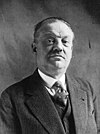
This is a list of mayors of Clermont-Ferrand. It includes all mayors (maires) of Clermont-Ferrand, France, since 1694.

This is a list of mayors of Clermont-Ferrand. It includes all mayors (maires) of Clermont-Ferrand, France, since 1694.
The mayors of Clermont-Ferrand from 1893 to present.
| Image | Mayor | Term start | Term end | Party | |
|---|---|---|---|---|---|
 | Pierre Lecuellé | 1893 | 1900 | I | |
 | Louis Renon | 1900 | 1904 | I | |
 | Antoine Marie-Charles Fabre | 1904 | 1912 | I (Republican) | |
 | Ernest Charles Vigenaud | 1912 | 1919 | PSR | |
 | Philippe Marcombes | 1919 | 1929 | PSR | |
 | Paul Gondard | 1929 | 1935 | PSR | |
 | Philippe Marcombes | 1935 | 1935 | PSR | |
 | Paul Pochet-Lagaye | 1935 | 1944 | PSR | |
 | Gabriel Montpied | 1944 | 1973 | PSR | |
 | Roger Quilliot | 1973 | 1997 | PS | |
 | Serge Godard | 1997 | 2014 | PS | |
 | Olivier Bianchi | 2014 | in office | PS |
The French organ school formed in the first half of the 17th century. It progressed from the strict polyphonic music of Jean Titelouze to a unique, richly ornamented style with its own characteristic forms that made full use of the French classical organ. Instrumental in establishing this style were Louis Couperin, who experimented with structure, registration and melodic lines, expanding the traditional polyphonic forms, and Guillaume-Gabriel Nivers (1632–1714), who established the distinct forms and styles of what was to become the French organ tradition.
La Loge des Neuf Sœurs, established in Paris in 1776, was a prominent French Masonic Lodge of the Grand Orient de France that was influential in organising French support for the American Revolution. A "Société des Neuf Sœurs," a charitable society that surveyed academic curricula, had been active at the Académie Royale des Sciences since 1769. Its name referred to the nine Muses, the daughters of Mnemosyne/Memory, patrons of the arts and sciences since antiquity, and long significant in French cultural circles. The Lodge of similar name and purpose was opened in 1776, by Jérôme de Lalande. From the start of the French Revolution in 1789 until 1792, Les Neuf Sœurs became a "Société Nationale".

Aubière is a commune located in the department of Puy-de-Dôme in the Auvergne-Rhône-Alpes region in southeast France. As of 2017 its population was 10,061.

Clermont-Dessous is a commune in the Lot-et-Garonne department in south-western France.
The Commission des Sciences et des Arts was a French scientific and artistic institute. Established on 16 March 1798, it consisted of 167 members, of which all but 16 joined Napoleon Bonaparte's conquest of Egypt and produced the Description de l'Égypte. More than half were engineers and technicians, including 21 mathematicians, 3 astronomers, 17 civil engineers, 13 naturalists and mining engineers, geographers, 3 gunpowder engineers, 4 architects, 8 artists, 10 mechanical artists, 1 sculptor, 15 interpreters, 10 men of letters, 22 printers in Latin, Greek and Arabic characters. Bonaparte organised his scientific 'corps' like an army, dividing its members into 5 categories and assigning to each member a military rank and a defined military role beyond his scientific function.

The Military governor of Paris is a post within the French Army. He commands the garrison of Paris and represents all the military based in Paris at high state occasions. He is also responsible for organizing major national ceremonies such as the Bastille Day military parade down the Champs-Élysées.

The Galerie des Batailles is a gallery occupying the first floor of the Aile du Midi of the Palace of Versailles, joining onto the grand and petit appartement de la reine. 120 m (390 ft) long and 13 m (43 ft) wide, it is an epigone of the grand gallery of the Louvre and was intended to glorify French military history from the Battle of Tolbiac to the Battle of Wagram.
Louis-Antoine-Marie Ledru Gaultier de Biauzat (1845-1886) was a French architect. He designed the market and schools in Clermont-Ferrand as well as the casino in Le Mont-Dore. He competed to design the spa in Le Mont-Dore, but Émile Camut's designs were chosen instead.